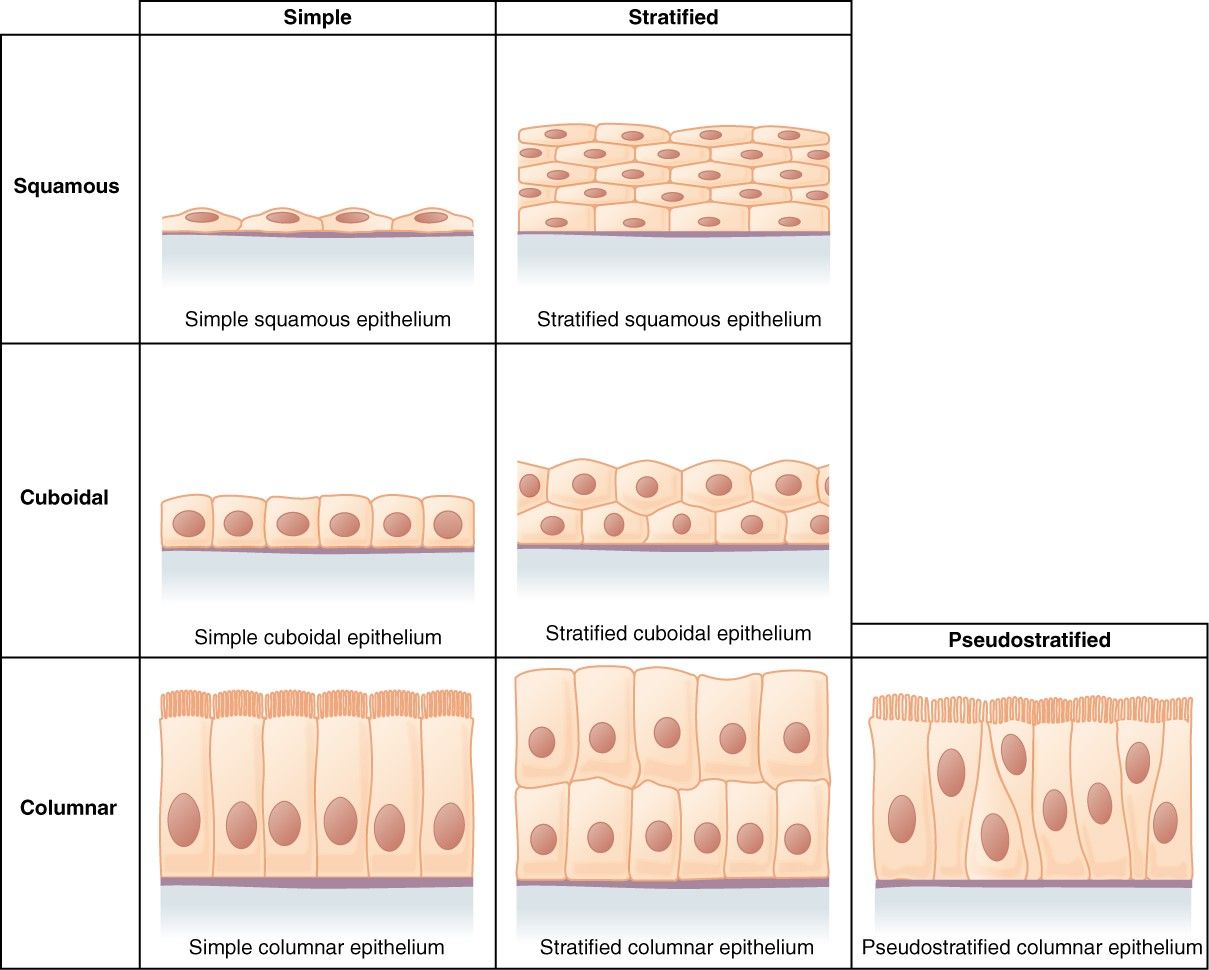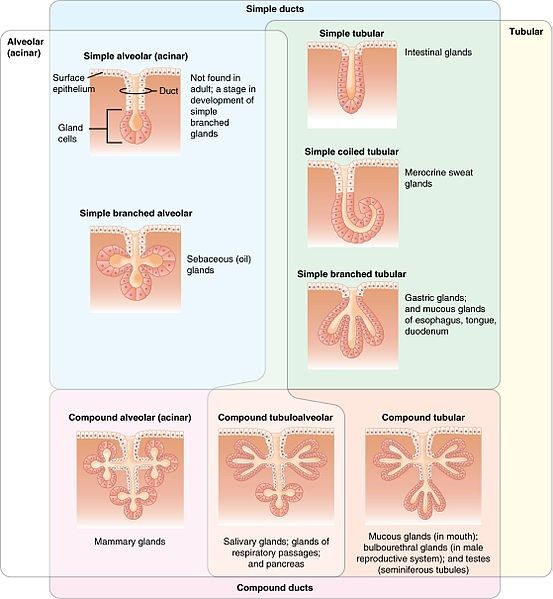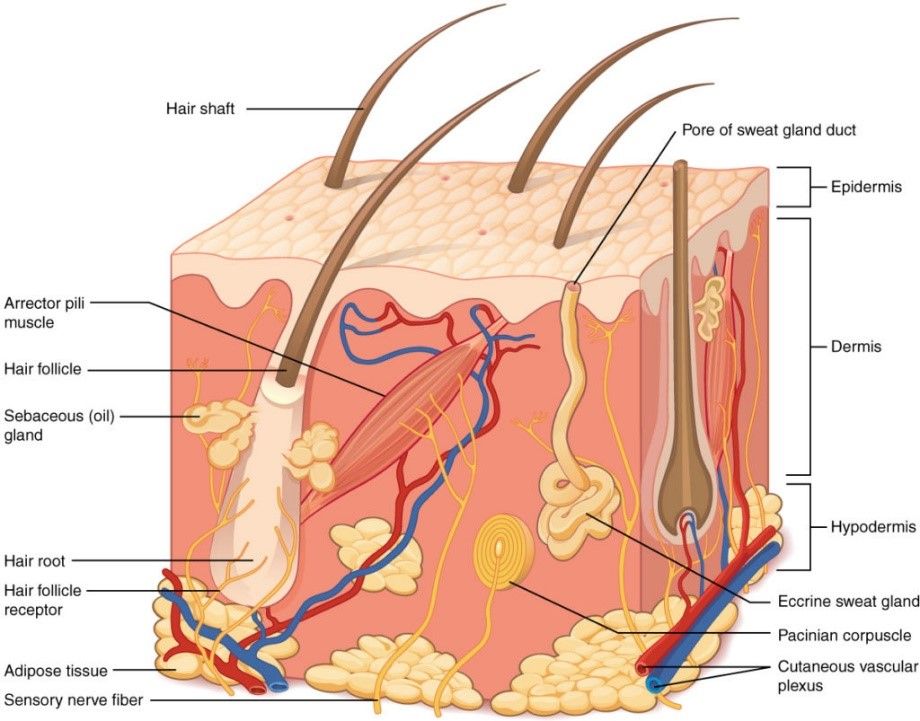By Benjamin Norris and Dr. Peter Parkinson
Next Lesson - Acute Inflammation
Abstract
- Epithelial tissue has a number of functions including secretion, absorption, protection and transport.
- Epithelium can be categorised by shape (squamous, cuboidal and columnar) and layering (simple, stratified, pseudostratified and transitional).
- Epithelial cells make up glands, being either exocrine which possess ducts, or endocrine glands which are ductless.
- The skin is the body’s largest organ and is made up of three layers - epidermis, dermis, and hypodermis.
Core
Epithelium is one of four basic tissue types in the human body. Epithelial sheets are made up of contiguous cells that cover the external surface of the body, line cavities and form glands.
Epithelium has several functions, including:
- Secretion
- Epithelium lines areas that have a high level of secretion, such as the gastrointestinal tract.
- Selective Absorption
- Epithelium is the first layer of cells in direct contact with materials which are absorbed by the body, e.g. intestinal epithelium. Epithelium can have specialised channels and transporters in the cell surface membrane to allow selective absorption.
- Protection
- Specialised epithelium can protect internal tissues from the external environment by acting as a barrier e.g. skin.
- Specialised Transport
- Some epithelial cells have a specialised cell membrane usually on the apical domain (the side facing into the lumen) that assists in the transport of substances e.g.
- Microvilli - extend cell surface to allow more absorption to take place e.g. in the small intestine
- Stereovilli - long microvilli e.g. in the inner ear
- Cilia - motile processes that beat in synchrony to move particles e.g. in the bronchi
- Some epithelial cells have a specialised cell membrane usually on the apical domain (the side facing into the lumen) that assists in the transport of substances e.g.
Basic Structure of the Epithelial Sheet
Epithelial cells are tightly packed together, joined to each other by specialised cell-to-cell junctions. The types of cell connections can assist with the function of the epithelium. The types of junctions joining epithelial cells are:
- Tight Junctions
- Firmly adhere cells to form and impermeable barrier that limits passage of molecules and ions and block the movement of integral membrane proteins.
- Allows tight control of the movement of substances across the epithelial layer e.g. in the nephron.
- Desmosomes
- Firmly locks cells together
- Allows resistance to stretching & twisting due to interlocking proteins.
- Gap Junctions
- Connexon proteins run between cells and form a channel between them
- Allows substance to pass between cells e.g. ions.
Epithelial cells rest atop a structure called the basement membrane and are joined to it by proteins called hemidesmosomes. The basement membrane is a thin protein-polysaccharide membrane which separates the epithelium from the underlying connective tissue and acts as an anchor for the epithelial cells.
Epithelium is avascular as it is not in contact with any blood supply directly. Epithelial cells receive nutrients and oxygen by diffusion through the environment or connective tissue.
Epithelial tissue can be categorised by the epithelial cell shape and the type of layering which is present.
- Cell shape
- Squamous (flat)
- Cuboidal
- Columnar
- Layers
- Simple (one layer)
- Stratified (multiple layers)
- Pseudostratified (literally “false layers”)
- The cells appear to be layered but are all in contact with the basement membrane
- Transitional
- Allows the cells to slide across one another. Transitional epithelium is found in the bladder as it allows the bladder to stretch as it fills with urine.

Table - The different types of epithelial tissue
Creative commons source by OpenStax College [CC BY-SA 4.0 (https://creativecommons.org/licenses/by-sa/4.0)]
A gland is an epithelial cell or collection of cells specialised for secretion. Secretion can be into the bloodstream or on to an epithelial surface. Glands can be classed by the presence or absence of ducts.
- Exocrine glands possess ducts e.g. the pancreas
- Endocrine glands don’t have ducts e.g. the pituitary gland
There are different structures of exocrine glands as shown below.

Table - The different types of glands
Creative commons source by OpenStax College [CC BY-SA 4.0 (https://creativecommons.org/licenses/by-sa/4.0)]
The skin is the largest organ of the body and has a number of functions. It acts as a physical barrier to the external environment, protecting against infection, physical damage and chemical damage. It also prevents excessive fluids from leaving the body and assists in temperature regulation.
Layers of the Skin
Epidermis is the most superficial (outermost) layer of the skin, which is made up of four layers of cells called keratinocytes. These cells are produced in the deepest layer of the skin (basal layer), then migrate up to external surface of skin in a process called cornification.
It takes a keratinocyte roughly 28-40 days to complete their journey from the stratum basale to the stratrum corneum. There are some conditions that reduce the time taken for this journey; for example, in psoriasis, there is an abundance of stratum corneum and silvery scales develop on the surface of the skin.
The four layers of the epidermis are:
- Horny layer (stratum corneum) – keratinocytes lose all their organelles and keratin production increases. This layer is thicker in sites such as palms of the hands, soles of the feet and the lips.
- Granular layer (stratum granulosum) – keratinocytes secrete waterproofing molecules such as lipids. These are essential for forming a protective barrier and keep in moisture.
- Prickle cell layer (stratum spinosum) – desmosomes (tight intracellular junctions) join the keratinocytes together tightly.
- Basal layer (stratum basale) - this layer is responsible for the mitosis of keratinocytes.
Dermis (middle)
The middle layer of the skin is called dermis and this layer is made of collagen, elastin, and other connective tissues. These components are integral for providing flexibility and strength to skin to protect against external forces. In comparison to the epidermis, the dermis is thicker, more elastic, and firm.
There are number different structures and cell types found in this layer of the skin:
- Blood vessels and cutaneous sensory nerves
- Mast cells – cells that contain histamine which is important for innate immune response.
- Fibroblasts – these cells are responsible for producing extracellular matrix, which includes collagen and elastin.
A pilosebaceous unit is the combination of a hair follicle and sebaceous gland. These units are only found on hairy skin (hirsute skin). A sebaceous gland produces a waxy or oily material into the hair follicle, which then travels onto the skin to lubricate the surface of the skin and hair.
There are two main types of sweat glands found in the dermis:
- Apocrine gland – large sweat gland typically found in the genital and axillary region. The products synthesised by these glands can be metabolised by microbes on the surface of the skin, which produces an odour.
- Eccrine gland – these sweat glands are found all over the body and secrete an odourless, clear substance. It contains mainly water and sodium chloride; important in the regulation of temperature.
Hypodermis (innermost)
An alternative name for the hypodermis is subcutaneous tissue. Majority of the body’s adipose tissue is found in this layer and varies in size between individuals depending on the amount of fat tissue present. The layer is highly vascularised.
This layer is important for storing energy reserves, acting as an attachment site for muscles below plus providing a smooth and contoured appearance to skin.
Medications such as insulin and adrenaline can be injected into this layer when being administered.

Diagram - The structure of the skin
Creative commons source by OpenStax College [CC BY-SA 4.0 (https://creativecommons.org/licenses/by-sa/4.0)]
There are a multitude of different cell types within the skin:
- Keratinocytes
- Synthesise keratin, a fibrous protein that gives the epidermis strength and is the main constituent of hair and nails.
- They undergo mitosis in the basal layer and then the daughter cells move up through the prickle cell layer. As they migrate, keratinocytes lose their ability to divide and lose their nuclei, eventually forming the horny layer. This layer provides a hydrophobic barrier for the skin due to the amount of keratin.
- Melanocytes
- Also located in the basal layer of the epidermis
- Synthesise melanin, which is a pigment that darkens skin and protects against UV damage.
- Individuals with darker skin have the same number of melanocytes as individuals with lighter skin, but each melanocyte produces a higher amount of melanin.
- Langerhans cells
- Antigen presenting cells that circulate between the epidermis and local lymph mediate immune responses.
Atopic Eczema
- A chronic hypersensitivity reaction that causes the skin to become itchy, red, dry and cracked. It can affect any part of the body.
- Although it is chronic, it can improve or disappear in young children.
- Primarily genetic and can be aggravated by allergens, heat and sweating.
Psoriasis
- Psoriasis is a skin condition that causes red, flaky, crusty patches of skin covered with silvery scales which normally affecting the elbows, knees, scalp, and lower back.
- The main features are proliferation of keratinocytes, inflammation and vascular changes in the skin.
- There are genetic immune factors at play, however, symptoms can follow trauma, infection and alcohol consumption.
Acne Vulgaris
- Acne vulgaris is a chronic skin disease involving the blockage of hair follicles and their accompanying sebaceous gland.
- Acne can present as non-inflammatory lesions, inflammatory lesions or a mixture of both, affecting mostly the face but also the back and chest.
- Acne can be caused by hormonal changes, inflammation and by bacterial colonisation of the affected areas.
Edited by: Dr. Maddie Swannack
Reviewed by: Dr. Thomas Burnell
- 9765

